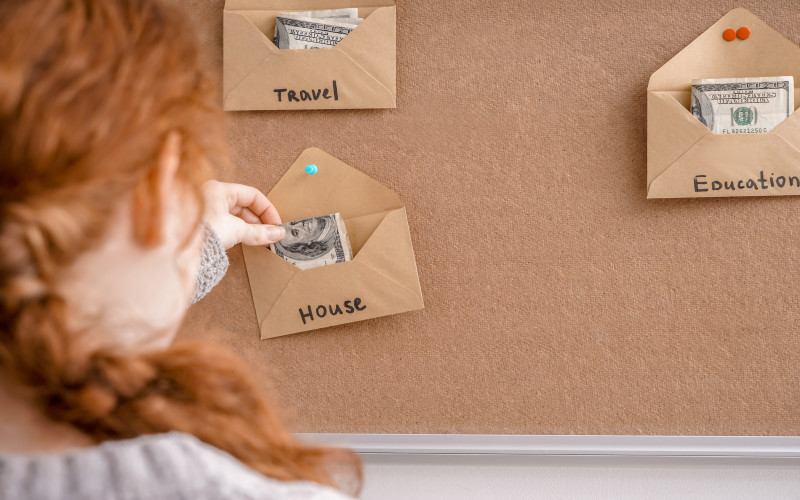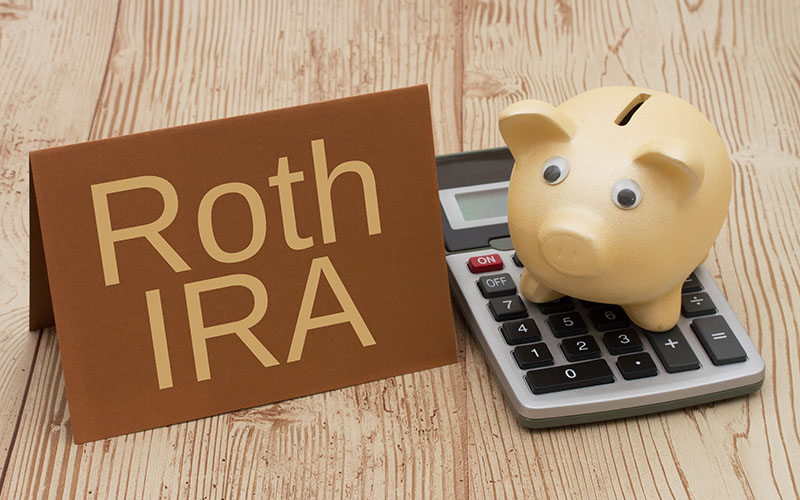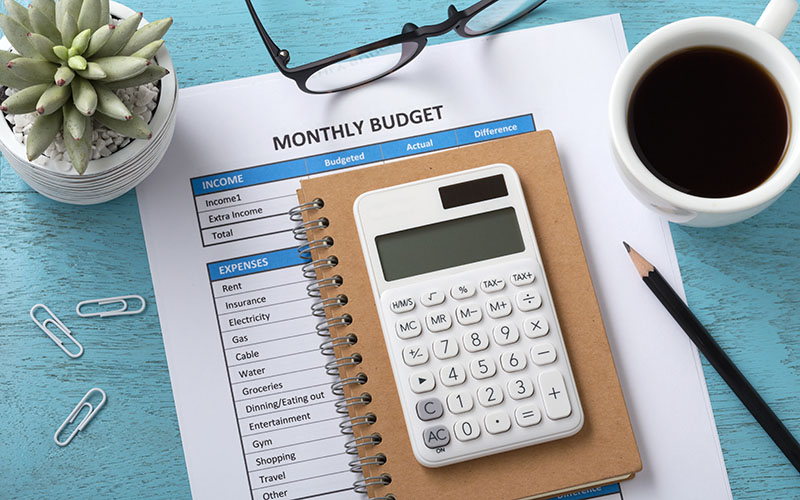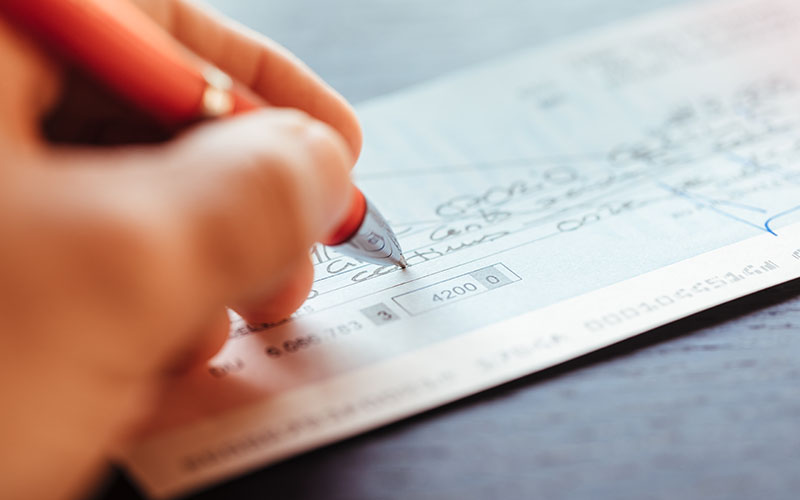Saving for Multiple Goals with the Envelope System
Key Takeaways
- The envelope system separates savings for each goal, making it easier to track progress and stay organized
- Using multiple savings accounts or digital “envelopes” helps protect emergency funds from being spent on other goals
- Automating deposits into each envelope keeps savings consistent and helps you reach goals faster

Saving is one of those things that everyone knows is important but is hard to actually do. Many people are barely making ends meet and rarely have money left over to save and those who are fortunate enough to have those extra funds may struggle to know the best way to save toward their goals.
It can be especially difficult to start saving if you have multiple goals that you want to work toward. How can you know what money is destined for each goal?
One way that you can easily save toward multiple goals at the same time is by using the envelope system for saving.

What is the Envelope System for Saving?
The envelope system for saving is a method of saving that designates every dollar you have for a certain purpose. In this way, it’s very similar to the envelope method for budgeting that’s taught by many financial experts, like David Ramsay.
Determine your goals
The first thing that you need to do to use the envelope system effectively is to determine your goals.
There are a lot of reasons to save money. Everyone should make sure they have an emergency fund that they can use to cover unexpected expenses, but beyond there, there are many goals you could be working toward.
Taking a vacation, buying new furniture, making a down payment on a house, buying holiday gifts for friends and family, and buying a new car are all great reasons to start setting aside some money.
Make a savings plan
Once you know your goals, you can start making a plan for how you’ll reach those goals. Some things, like buying a house, take a long time. You can’t just decide to start saving for a down payment and expect to have one within a few months.
Sit down with your monthly budget (if you don’t have one, then this is the perfect time to build one). If you’ve built saving money into your budget already, divide that amount among your different savings goals. If your budget doesn’t include saving, try to find some places you can reduce your spending so you can save that money instead. Every little bit helps.
How much you should save toward each goal depends on the size of the goal and how long you want it to take before you reach that goal.
For example, if in January you decide that you want to spend $500 on buying holiday gifts for the family, you know that you have twelve months to reach that goal. You have to save about $42 each month to have $500 after twelve months, so that’s the amount that you should save.
Unless you make a huge amount of money each year or have modest savings goals, you may have to make hard decisions during this step about what to prioritize. Personal finance is a personal thing, so think about which goals are most important to you and allocate the money that you can save accordingly.
Once you’ve determined your savings goals and have decided how much to put toward those goals each month, you’re ready to put your plan into action.
Create multiple “envelopes”
One of the most popular ways to save money is by using a savings account. You put money into the account and the bank keeps your money safe. Depending on the bank that you use, you’ll earn interest that can help you reach your savings goals faster.
The drawback of this system is that your savings account will only show one balance. If you have one savings account and multiple savings goals, it’s hard to know how much money is designated for each goal.
At its most basic level, the envelope system for saving means keeping the money you’ve saved toward each goal separate. For example, you could keep all of your savings in cash and place the correct amount in different envelopes with your goals written on them, though this isn’t the safest way to save.
The better plan would be to open multiple savings accounts, one for each goal. You can deposit money to each account and watch their balances grow. When you want to know your progress toward each goal, you can look at the balance of the relevant account.
With some banks, opening multiple savings accounts can be difficult. Others make it very easy or even let you set up envelopes within a single account which can make it much easier to implement this kind of system.
One service that can make this saving strategy easier is Qube Money. Qube Money helps people budget and save using the envelope system (though it calls each envelope a Qube).
When you sign up for Qube Money’s free service, you can create up to 10 Qubes to hold your savings, making it easy to track your progress toward ten different goals.
For between $8 and $25 per month, you can unlock additional features such as unlimited Qubes, budget automation, and the option to add a partner or children to your account and get linked debit cards for them.
Start saving and track your progress
Once you’ve built your envelopes, it’s time to start saving.
One of the hardest parts about saving is remembering to do it on a consistent basis. The best savings plan won’t work if you don’t remember to put money in your savings account.
Automation is a very important thing to make saving easy. Most banks will offer features like automatic transfers from checking accounts to savings accounts. Set up these transfers so you don’t even have to think about setting money aside and you’ll see your savings grow.
Some employers even offer the option to split your direct deposit between multiple bank accounts. This can be another way to automate your savings as you can ask your employer to deposit the correct amount to each of your savings account with every single paycheck you receive.
Every once in a while, check in on your savings progress to make sure things are working as you expect. You can also take a moment to assess your saving priorities or update your budget to increase the amount you can save each month.
Why Use the Envelope System for Saving?
The envelope system has a lot of advantages that make it a great way to save.
Separate goal funds from emergency funds
Having an emergency fund is important. Everyone faces unexpected expenses sometimes. Whether it’s a hospital bill, a car repair, or a friend in need, having some cash set aside can help you avoid debt and financial stress.
If you don’t have a good way to keep your emergency fund separate from your savings toward financial goals, you can easily wind up not having an emergency fund at all. You’ll see the balance of your savings account and feel comfortable, but if you ever have to use it for an emergency, you’ll wipe out your progress toward taking a vacation or buying a car.
Keeping your emergency fund and your savings toward goals in separate accounts lets you truly know how much money you have in case of an emergency and makes it easier to use your other savings for its intended purpose.
Keep track of multiple goals
Beyond separating your savings from your emergency fund, the envelope system makes it much easier to keep track of multiple goals. If you want to save $5,000 to buy a car, $2,000 to take a trip, and $500 to buy holiday gifts you’ll know that you need $7,500 in total.
However, when you look at your savings account and see $3,800 in the account, do you know which of those goals you’ve reached? You might have reached two of the goals or none of them.
With the envelope system, you’d have a separate account for each goal so you can quickly and easily know how much money you’ve put toward each goal and whether you’ve reached any of your targets.
Disadvantages of the Envelope System for Saving
The envelope system has a lot of perks, but it isn’t perfect. Before you decide to use it, make sure that you know the drawbacks.
More accounts means more to keep track of
Unless your bank offers an envelope style system for tracking your money, the best way to implement this system is to set up a separate savings account for every goal you have.
Setting up that many accounts can be a hassle. It also means that you have more accounts to keep track of.
If you keep all of the accounts at the same bank, it can mitigate the problem, but you’ll still have to search through the accounts for the right one when you want to make a transfer or check a balance.
May be more difficult to know how much money you have
One of the benefits of putting all your money in a single account is that you can easily find out precisely how much money you have. All you have to do is look at your account balance.
If you split your savings between multiple accounts, it can be difficult to know how much money you have. You have to take the time to add up all of the balances to find your total balance.
Usually, this isn’t a big deal but if you’re hit with a financial catastrophe or find yourself in another situation where you need a large sum of cash very quickly, it can be helpful to know exactly what financial resources you have available. Splitting money between accounts can make it take just a bit longer to find out.
How to Make the Most of Your Savings
One of the best places to put your extra money is in a savings account. Banks can keep your money safe, but they also pay interest on the balance of savings accounts.
However, not every bank is equal when it comes to savings account options. Many banks’ interest rates are so low that you’ll be lucky to earn pennies each year. While these banks can still keep your money safe, they’re not the best place to keep your savings.
The interest your money earns can help you reach your goals faster, so you want to make sure you choose a bank that pays a reasonable rate of interest.
In general, online banks will offer higher interest rates than brick and mortar banks. They also tend to have lower account minimums and fees, making it easier to start saving, even if you don’t have much money to save.
Some companies, like SaveBetter.com, match people with savings accounts that offer high interest rates while offering other perks, like increased FDIC protection.
Choosing the savings accounts you’ll use for your savings goals is an important step. Look for accounts with good interest rates and low fees.

Conclusion
Saving toward your financial goals is important, but it can be hard to keep track of your progress if you have a lot of things you want to do. The envelope system, which involves opening separate savings accounts for each goal, can make it much easier to keep track of your progress and help you stay motivated to keep saving.
What is the envelope system?
The envelope system for saving is a method of saving that takes every dollar you have and puts it towards a specific purpose.
Edited by:
Bryan Huynh
•
Product Tester & Writer








